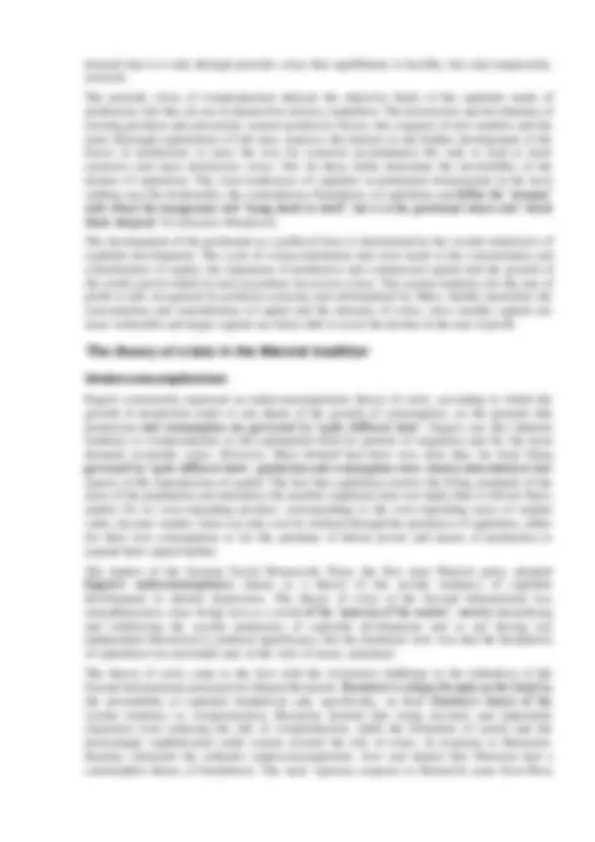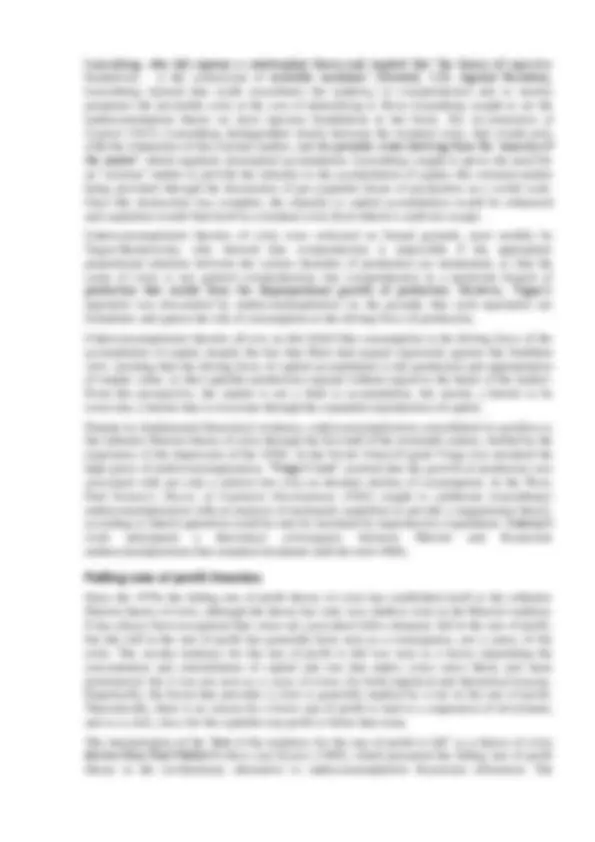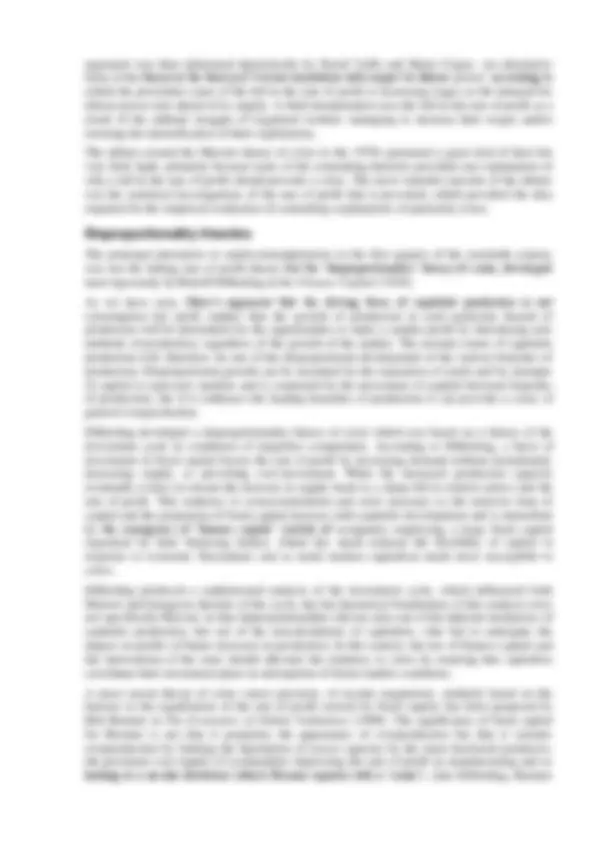





Study with the several resources on Docsity

Earn points by helping other students or get them with a premium plan


Prepare for your exams
Study with the several resources on Docsity

Earn points to download
Earn points by helping other students or get them with a premium plan
Community
Ask the community for help and clear up your study doubts
Discover the best universities in your country according to Docsity users
Free resources
Download our free guides on studying techniques, anxiety management strategies, and thesis advice from Docsity tutors
Crisis theory in economics by carl marx
Typology: Lecture notes
1 / 6

This page cannot be seen from the preview
Don't miss anything!




The recurrence of economic crises is an undisputed fact of capitalism, yet economists explain each successive crisis as a singular event, usually attributed to the subjective failings of capitalists and/or of government regulation of the economy, but never to the capitalist system. For Marxists, by contrast, the tendency to crisis is inherent in capitalist accumulation, an expression of the fundamental contradictions of capitalism. Yet there is no generally agreed Marxist theory of crisis.
Despite the central role played by the theory of crisis in Marxism, Marx himself never developed a complete theory of crisis. On the one hand, Marx was primarily concerned with analysing the secular tendencies of capitalist development, marked by the concentration and centralisation of capital and the polarisation of classes, that underpinned the progressive development of the working class movement that would culminate in the inevitable revolution and, after the 1850s, he had much less confidence in the revolutionary potential of economic crises. On the other hand, from a theoretical point of view, the analysis of economic crises presupposes the analysis of competition and credit that Marx never completed, so in his notebooks Marx regularly postponed a full discussion of economic crises on these grounds. Nevertheless we can outline the key elements of Marx’s analysis.
An economic crisis occurs when capitalists are unable to sell their commodities without incurring substantial losses, which reverberate through the system in a chain of defaults, curtailing production in a cumulative downward spiral. The theoretical issue is to explain such a systemic market failure.
The abstract possibility of crisis is already contained in the separation of purchase and sale that is a feature of the production and exchange of commodities for money. If a significant number of sellers withdraw their money from circulation, rather than using it to buy further commodities, then the latter commodities will remain unsold. For political economy such an outcome would be completely irrational since for political economy, as Adam Smith put it, ‘consumption is the sole end and purpose of all production’, so the only purpose of selling one commodity would be to buy another. For Marx, by contrast, the ‘sole end and purpose’ of capitalist production is not consumption but the accumulation of capital through the production and appropriation of surplus value. The sale of commodities represents the reconversion of the capitalist’s expanded capital into the form of money with which to renew the process of capital accumulation. The capitalist will devote some of the money realised to his own consumption, but the remainder will be reinvested, provided only that there are opportunities for its profitable investment. Marx therefore identifies the condition for crisis as the absence of such opportunities. Capitalists will withdraw their money from circulation if they cannot invest it profitably, thereby precipitating a crisis.
Under what conditions does it become impossible for capitalists to invest profitably? Marx argues that we cannot find any such conditions in the sphere of production. The condition for the production of surplus value is merely the condition of possibility of capitalist production – that the productivity of labour should be sufficient that the labourer can produce a surplus above his or her subsistence needs and that the labourer should be ‘free’, compelled to sell his or her labour power. Nor does Marx find any such conditions in the sphere of circulation since, in abstraction from any other considerations, exchange is the sphere of freedom and equality, in which commodities exchange at their values. The problem must arise in the relationship between production and circulation, in the realisation of the surplus value that has been produced. ‘The conditions of direct exploitation, and those of realizing it, are not identical. They diverge not only in space and time, but also logically. The first are only limited by the productive power of
society, the latter by the proportional relation of the various branches of production and the consumer power of society’ ( Capital , vol. III, p. 239).
The origins of the crisis lie in the overproduction of commodities in relation to the effective demand at a price that makes it possible to realise the surplus value embodied in those commodities. But what is the source of such overproduction? This is the point at which Marx parts company decisively with political economy.
For political economy competition ensures that overproduction is liquidated through the movement of capital between branches of production. Say’s law of markets guarantees that ‘general overproduction’ is impossible, so overproduction in one branch can only arise as a result of disproportionality, with underproduction arising in another branch. The rate of profit in the former branch will be lower and in the latter higher than the average, so capital in the latter branch will move to the former branch to restore equality of profit rates and the proportionality of production. If disproportionality reaches the stage of crisis it can only be because overproduction has been sustained ‘unnaturally’ by the speculative expansion of credit. For political economy, therefore, a crisis was essentially a monetary phenomenon that arose as a result of inappropriately lax regulation by the monetary authorities.
For Marx overproduction is not an accidental divergence from the norm of proportional growth, to be eliminated smoothly by competition, but is the essential characteristic of capitalist production. Overproduction is the cause and consequence, the essential form, of capitalist competition. The purpose of capital is not, as the economists propose, to meet consumer demand, but to make profits, and the primary means by which capitalists make profits is not by moving their capital between branches of production in response to marginal differences in the rate of profit, but by introducing new methods of production to reduce their costs of production. A capitalist who can produce more cheaply than his competitors will produce as much as he can, to drive his competitors out of the market. The increased production leads to falling prices as supply runs ahead of demand and the more backward capitalists are forced to reduce their costs in turn. If they do not have the resources to introduce new methods of production, they cut their costs by reducing wages, intensifying labour and lengthening the working day. Eventually supply is brought back within the limits of demand as the less profitable capitalists are bankrupted or withdraw from the battle and their workers are thrown on the scrap heap.
The tendency to overproduction is not an exceptional event, it is the everyday reality of capitalist production, forcing capitalists, on pain of extinction, constantly to expand their markets and cut their costs. The positive side of this contradictory feature of capitalism is that the most advanced capitalists constantly create new products and develop new methods of production. However, new products are not developed to meet human needs, nor are new methods of production developed to lessen the burden of labour. Capital accumulation is marked by the constant creation of new needs, by the increasing polarisation of wealth and poverty, the coexistence of overwork and unemployment. For Marx capitalism was progressive in developing methods of production and new ways of meeting human needs, but the progressive side of capitalism could only be realised in a new kind of society in which production would be subordinated not to profit but to human need.
Marx and Engels believed that this tendency to overproduction was a feature of the everyday reality of capitalist production, pressing on every capitalist in the form of competition, but they believed that it also gave rise to periodic, and increasingly severe, general crises which arise when overproduction, spurred on by speculation and sustained by the expansion of credit, affects the leading branches of production. Marx and Engels saw these periodic crises as a recurring phase of the cyclical pattern which is the normal form of capitalist accumulation. Against the economists' presumption that the interaction of supply and demand ensures a constant tendency towards equilibrium as capitalists adjust production to the limits of the market, Marx and Engels
Luxemburg, who did espouse a catastrophist theory and insisted that ‘the theory of capitalist breakdown… is the cornerstone of scientific socialism’ (Howard, 123). Against Bernstein, Luxemburg insisted that credit exacerbates the tendency to overproduction and so merely postpones the inevitable crisis at the cost of intensifying it. Rosa Luxemburg sought to set the underconsumption theory on more rigorous foundations in her book, The Accumulation of Capital (1913). Luxemburg distinguished clearly between the terminal crisis, that would arise with the exhaustion of the external market, and the periodic crises deriving from the ‘anarchy of the market’ which regularly interrupted accumulation. Luxemburg sought to prove the need for an ‘external’ market to provide the stimulus to the accumulation of capital, this external market being provided through the destruction of pre-capitalist forms of production on a world scale. Once this destruction was complete, the stimulus to capital accumulation would be exhausted and capitalism would find itself in a terminal crisis from which it could not escape.
Underconsumptionist theories of crisis were criticised on formal grounds, most notably by Tugan-Baranowsky, who showed that overproduction is impossible if the appropriate proportional relations between the various branches of production are maintained, so that the cause of crisis is not general overproduction, but overproduction in a particular branch of production that results from the disproportional growth of production. However, Tugan’s argument was discounted by underconsumptionists on the grounds that such arguments are formalistic and ignore the role of consumption as the driving force of production.
Underconsumptionist theories all rest on this belief that consumption is the driving force of the accumulation of capital, despite the fact that Marx had argued vigorously against this Smithian view, insisting that the driving force of capital accumulation is the production and appropriation of surplus value, so that capitalist production expands without regard to the limits of the market. From this perspective, the market is not a limit to accumulation, but merely a barrier to be overcome, a barrier that is overcome through the expanded reproduction of capital.
Despite its fundamental theoretical weakness, underconsumptionism consolidated its position as the orthodox Marxist theory of crisis through the first half of the twentieth century, fuelled by the experience of the depression of the 1930s. In the Soviet Union Evgenii Varga was anointed the high priest of underconsumptionism. ‘Varga’s Law’ asserted that the growth of production was associated with not only a relative but even an absolute decline of consumption. In the West, Paul Sweezy's Theory of Capitalist Development (1942) sought to synthesize Luxemburg's underconsumptionism with an analysis of monopoly capitalism to provide a stagnationist theory, according to which capitalism could be only be sustained by unproductive expenditure. Sweezy’s work anticipated a theoretical convergence between Marxist and Keynesian underconsumptionism that remained dominant until the mid-1960s.
Since the 1970s the falling rate of profit theory of crisis has established itself as the orthodox Marxist theory of crisis, although the theory has only very shallow roots in the Marxist tradition. It has always been recognised that crises are associated with a dramatic fall in the rate of profit, but this fall in the rate of profit has generally been seen as a consequence, not a cause, of the crisis. The secular tendency for the rate of profit to fall was seen as a factor stimulating the concentration and centralisation of capital and one that makes crises more likely and more pronounced, but it was not seen as a cause of crises, for both empirical and theoretical reasons. Empirically, the boom that precedes a crisis is generally marked by a rise in the rate of profit. Theoretically, there is no reason for a lower rate of profit to lead to a suspension of investment, and so a crisis, since for the capitalist any profit is better than none.
The interpretation of the ‘law of the tendency for the rate of profit to fall’ as a theory of crisis derives from Paul Mattick’s Marx and Keynes (1969), which presented the falling rate of profit theory as the revolutionary alternative to underconsumptionist Keynesian reformism. The
argument was then elaborated theoretically by David Yaffe and Mario Cogoy. An alternative form of the theory is the theory of ‘overaccumulation with respect to labour power’, according to which the proximate cause of the fall in the rate of profit is increasing wages as the demand for labour power runs ahead of its supply. A third interpretation sees the fall in the rate of profit as a result of the militant struggle of organised workers managing to increase their wages and/or resisting the intensification of their exploitation.
The debate around the Marxist theory of crisis in the 1970s generated a great deal of heat but very little light, primarily because none of the contending theorists provided any explanation of why a fall in the rate of profit should provoke a crisis. The most valuable outcome of the debate was the statistical investigations of the rate of profit that it provoked, which provided the data required for the empirical evaluation of contending explanations of particular crises.
The principal alternative to underconsumptionism in the first quarter of the twentieth century was not the falling rate of profit theory but the ‘disproportionality’ theory of crisis, developed most rigorously by Rudolf Hilferding in his Finance Capital (1910).
As we have seen, Marx’s argument that the driving force of capitalist production is not consumption but profit implies that the growth of production in each particular branch of production will be determined by the opportunities to make a surplus profit by introducing new methods of production, regardless of the growth of the market. The normal course of capitalist production will, therefore, be one of the disproportional development of the various branches of production. Disproportional growth can be sustained by the expansion of credit and by attempts of capital to open new markets and is countered by the movement of capitals between branches of production, but if it embraces the leading branches of production it can provoke a crisis of general overproduction.
Hilferding developed a disproportionality theory of crisis which was based on a theory of the investment cycle in conditions of imperfect competition. According to Hilferding, a burst of investment in fixed capital boosts the rate of profit by increasing demand without immediately increasing supply, so provoking over-investment. When the increased production capacity eventually comes on stream the increase in supply leads to a sharp fall in relative prices and the rate of profit. This tendency to overaccumulation and crisis increases as the turnover time of capital and the proportion of fixed capital increase with capitalist development and is intensified by the emergence of ‘finance capital’ (cartels of companies employing a large fixed capital organised by their financing banks), which has much reduced the flexibility of capital in response to economic fluctuations and so made modern capitalism much more susceptible to crises.
Hilferding produced a sophisticated analysis of the investment cycle, which influenced both Marxist and bourgeois theories of the cycle, but the theoretical foundations of this analysis were not specifically Marxist, in that disproportionalities did not arise out of the inherent tendencies of capitalist production, but out of the miscalculations of capitalists, who fail to anticipate the impact on profits of future increases in production. In this context, the rise of finance capital and the intervention of the state should alleviate the tendency to crisis by ensuring that capitalists coordinate their investment plans in anticipation of future market conditions.
A more recent theory of crisis (more precisely, of secular stagnation), similarly based on the barriers to the equalisation of the rate of profit erected by fixed capital, has been proposed by Bob Brenner in The Economics of Global Turbulence (1998). The significance of fixed capital for Brenner is not that it postpones the appearance of overproduction but that it sustains overproduction by limiting the liquidation of excess capacity by the more backward producers, the persistent over-supply of commodities depressing the rate of profit in manufacturing and so leading to a secular downturn (which Brenner equates with a ‘crisis’). Like Hilferding, Brenner